Working toward a common goal
Editor's note: Nelson Whipple is vice president at John Morton Company, a Chicago consulting firm.
Every business faces the core marketing challenge of how to drive sales to meet corporate financial goals through successful development and delivery of offerings to the market. While effective marketing research supports these development and delivery activities, it is often difficult to translate survey research findings into tactical actions that meet the corporate goals. There may be a significant gap between the delivery of the research and the identification of the tactical actions to take and who should take them.
For B2B marketers, it is especially critical to link research findings to business realities. In many B2B markets, customers cannot self-select into needs segments the way consumers can. By contrast, a typical B2B sales force has to actively identify leads and know which value proposition to introduce proactively to a prospect. Many B2B markets, such as chemical markets, have a very limited customer base with which to work; cost of sale can be high and opportunities for new sales may be few, so it is critical for sales people to be able to focus their efforts on activities that will have the highest success rate with accounts. Finally, compared to typical B2C markets, B2B market research is expensive, so it is imperative to find cost-effective alternatives with which to augment costly survey work and to link research results back to the internal business environment.
In order to assure the usability of marketing research, a systematic, integrative process that uses six tools is introduced below. The process integrates business perspectives with research approaches and different sources of information with each other. Researchers structure their design and analysis according to the realities of business goals and available tactical alternatives. Once an initial business objective is identified, a solid systematic process follows with these steps:
1. Choose an appropriate strategic framework that will guide the analysis and recommendations and define criteria for segments.
2. Document the business goals, potential value proposition components, and tactical alternatives.
3. Identify and procure the necessary information sources; design and execute custom research as needed.
4. Define the market opportunity structure and create a scorecard for segment opportunity from the information analysis.
5. Map segments to the key value proposition components that drive their behavior.
6. Map segments back to tactical alternatives.
7. Map tactics back to the functional areas that will be accountable for them.
At each step, engaging the business planner in the research process will add value to the final deliverable.
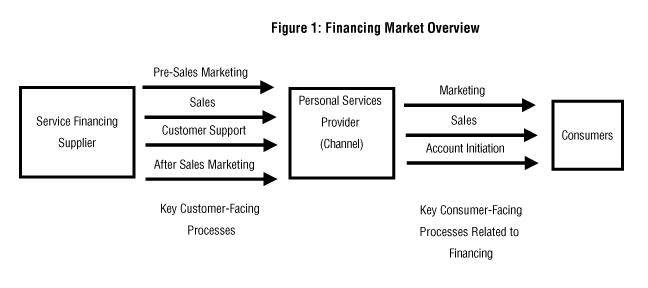 |
To illustrate this process, a business case will be discussed. In this case, a supplier of consumer financing for personal services planned to enter a new industry segment. The business model prohibited direct marketing to consumers, as this would incur high costs. Instead, the financing supplier would market through the service provider as a channel and deliver the necessary tools to them to offer financing to their own customers (Figure 1). The financing supplier's B2B marketing communications and actions must convince channels in the new segment 1) to carry their financing program and 2) to aggressively sell its financing plans to consumers instead of competitors' plans or cash payments.
1. Strategic framework
Figure 2 illustrates a solid strategic framework that applies to many marketing challenges. Using criteria across three dimensions, the framework enables the marketer and business planner to prioritize segments and individual accounts.
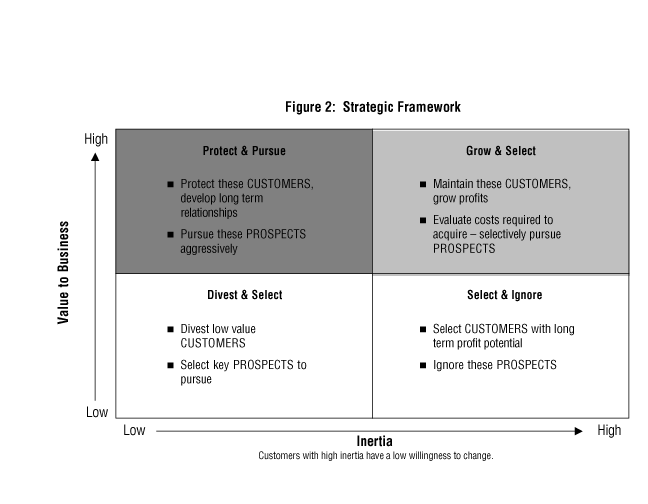 |
The first dimension, embedded in the chart, is Customer vs. Prospect. This is a critical and often overlooked dimension of research analysis. A single finding can lead to one strategy if it concerns customer retention or to something quite different if it concerns acquiring a prospect.
The next dimension is Value to the Business; if all else is equal, some accounts are more valuable than others. Value to the Business can mean high margin, high revenue, strategic importance, or other criteria to be established with the business planner during this step. The researcher will translate these criteria into variables that will segment accounts and identify alternative information sources (including custom survey research).
The third dimension is Inertia, or unwillingness to switch. The Inertia dimension is important to consider: it relates directly to potential market share and cost to sell. Two accounts that look identical in other ways may have completely opposite impact on profitability based upon this dimension. High Inertia is good for retaining customers, but makes it difficult or costly to acquire prospects.
The researcher must advise the business planner on how to best represent Inertia in the analysis based upon the available resources, likely methodology, and strategic needs. Proxies for Inertia could include ratings of willingness to switch, number of suppliers used, loyalty indices, gaps in perceptual ratings between the current supplier and competitors, etc.
Returning to the market entry case of the financing provider, defining customer versus prospect was simple: there were virtually no customers, so every business in the industry segment was a prospect. High versus low value was determined according to the expected amount of financed money that each prospect could generate if acquired. High versus low Inertia had two components: 1) the preference for the new financing supplier's value proposition versus current suppliers and 2) the channel's commitment to growing their business through financing.
2. Document the business
The design of the information gathering and the analysis of the data must be guided by the business realities, including the financial goals, the potential value proposition components, and the tactical alternatives. The business has a financial target for revenue, units, or profit, and that target will be based upon today's performance and assumptions about future market size and growth, achievable market share, time frame, and other assumptions.
In our case, the financing supplier targeted growth from their current incidental $10 million revenue in the segment to $300 million in the first year of aggressive marketing. This target was based upon industry reports that projected the total market for personal services in this segment to be $30 billion and their own assumptions that 10 percent of this total would be financed and that they could achieve 10 percent market share in Year 1.
To understand the feasibility of the market share goal and to estimate Inertia, it was important to evaluate the proposed value proposition relative to competitive offerings. The components of the current value proposition and alternatives were defined through internal discussions, and competitive intelligence research on competitors' Web sites, print ads and brochures, and in-depth market interviews.
Once the value proposition components are established, it is critical to document the tactical alternatives required to deliver them. There are two key steps in documenting the tactics. First, define the customer contact process as it applies to the business and its competitors over the life cycle of the customer relationship. Next, document the different actions that might be taken to execute each process step.
In the financing supplier example, the following customer processes were identified: pre-sales marketing, sales, customer support, and after-sales marketing. Within each process, a series of action alternatives were identified (see examples in Figure 6). For other businesses, the contact model may be more complex or more detailed than in this example.
Each tactic carries a different cost and a different expected effectiveness rate. Therefore, it is important to segment the market to validate, for example, where the more costly tactics are required and, if they are required, to allocate them to the high value/low Inertia segments.
3. Information gathering
Once the business issues are sufficiently defined, information gathering becomes a matter of identifying the appropriate sources and acquiring them within the time and monetary budgets. Many sources of information exist, but some information can only be created via custom research.
In the financing supplier case, a syndicated report was purchased prior to the custom research design. A review of the report identified channel segments with businesses that were too small to be of interest and some that were outside the scope of the business strategy (e.g., government agencies). The report also identified a small number of very large companies that represented a high potential channel with a unique business model. These were excluded from the research, but, as a result of this finding, senior management immediately established a new corporate business development function to pursue this new opportunity.
A 20-minute phone survey was designed to measure satisfaction with current value propositions, behaviors and expectations that would affect volume projections, and other parameters. Integrating these data with the analysis of the syndicated report enabled the market opportunity structure to be defined.
4. Market opportunity structure
Once the information is assembled, the market opportunity structure must be established before diving into detailed analysis. Laying out the structure of the opportunity according to the business plan assumptions provides a check on those assumptions and directs the analysis into more fruitful activities. If this check is not performed, the analysis becomes biased by the initial assumptions, and the voice of the customer is compromised.
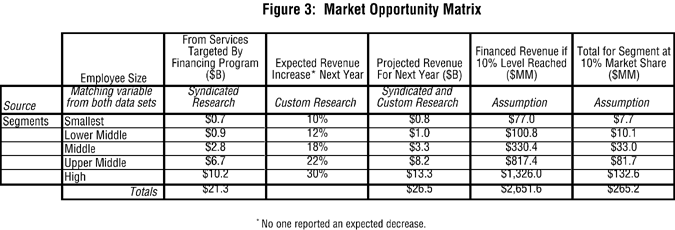 |
Figure 3 illustrates the opportunity structure for the financing supplier's market according to the business assumptions. The market is stratified by employee size, a variable that correlated well with the Value to the Business parameter from the strategic framework. Across the table, the market size projections are carried through using syndicated research, custom research and the business' assumptions. This tool is dynamic, and the business can make new assumptions or substitute segment research findings for the financing level and market share assumptions to adjust the forecasts.
The market opportunity view demonstrated one immediate finding: If the current business assumptions were correct, the financing supplier would not reach its goal of $300 million. Because the smaller businesses could contribute so little, the financing provider would have to shift its focus from a 10 percent market share goal across the board toward gaining a dominant market share within key segments of high volume accounts in order to meet its financial goals. The detailed analysis would have to focus on finding opportunities to achieve dominance among larger accounts; further analysis of the smaller businesses would be largely irrelevant.
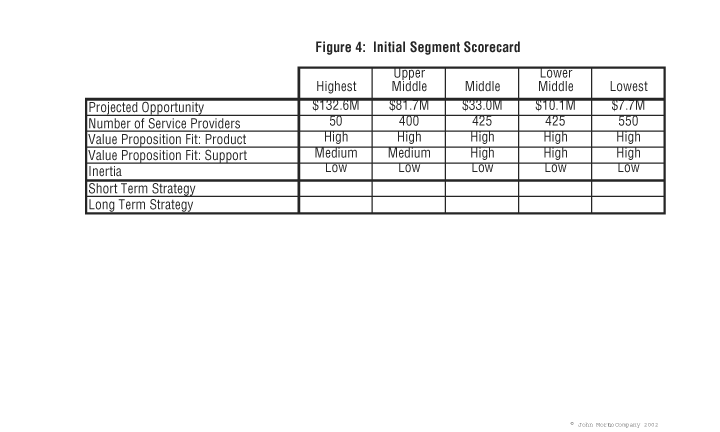 |
The segment scorecard is another tool that helps focus the analysis (Figure 4). An initial scorecard is developed for the known segments, and is refined as the detailed analysis progresses. In this example, the scorecard has five components:
- size of opportunity;
- number of businesses in the segment;
- value proposition fit for the product components;
- value proposition fit for the support components;
- inertia.
The first two parameters are critical to framing the business strategy, as they provide a snapshot of each segment's value to the business and the potential cost to sell. For example, the Middle segment has the same number of businesses as the Lower Middle, yet holds three times the revenue opportunity. This has tremendous implications for sales force hiring and deployment; it may not be worthwhile to hire sales people to serve the lower two market segments.
The next three parameters indicate segment penetrability. In this case, the value proposition is divided into two sets of components: product and support. The satisfaction levels with the existing providers' current product features and support levels were analyzed, and the results indicated a strong fit for the new financing product across all segments. The financing provider's proposed product features in every case exceeded the levels the market claimed they currently received, and the satisfaction levels were mediocre. This established that they could successfully penetrate the market as far as product issues were concerned.
Finally, each segment had a low level of Inertia, a positive finding for the supplier. As a new market entrant, they could easily switch businesses to their financing plans. The product and service fits were good, especially compared to competition. Results from competitive intelligence activities and survey analysis revealed competition to be fragmented, and no competitor was in a position to respond to an aggressive threat.
Further analysis identified the best targets for switching within the employee size segments: channels already financing more than 10 percent of their revenue. These were more likely to switch and more likely to aggressively offer financing. However, for the 50 businesses in the top segment, current financing level was irrelevant: gaining a high share among them would be critical to achieving the $300 million goal regardless of the barriers presented by their current practices. Given this further segmentation, the market opportunity and segment profiles tools were revised, and the strategy came more clearly into focus.
5. Map segments to value proposition
Mapping the segments back to the value proposition is an important bridge between the segment analysis and the tactical plan. Figure 5 shows a simplified analysis of the segments versus aspects of the value proposition. In the case of the financing provider, it shows that the least desirable segments have the highest needs. The high cost to serve these segments makes them even less desirable.
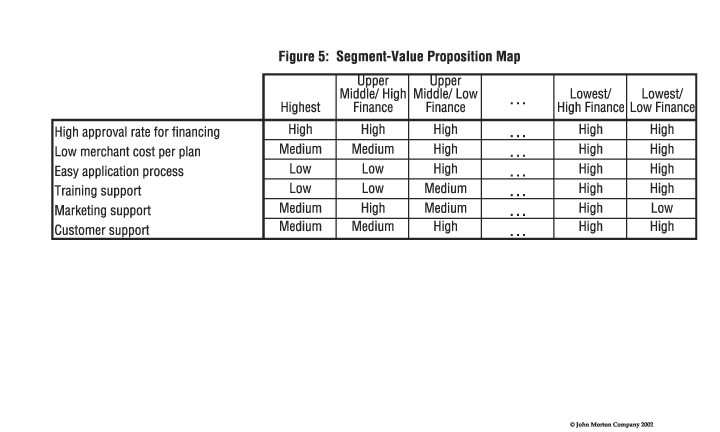 |
Analysis of the most desirable segment poses a different challenge. They may be convinced to switch to the new financing supplier based upon product features, but once they are converted there is very little opportunity to build Inertia via other elements of the value proposition. As implied in the earlier analysis, this segment would require a whole new approach.
6. Map segments to tactics
During the documentation phase with the business planner, the anticipated tactical alternatives are identified. In the course of the market research analysis, other tactics may be identified to augment the original list. These tactical alternatives can be mapped to the segments and systematically evaluated with the business planner.
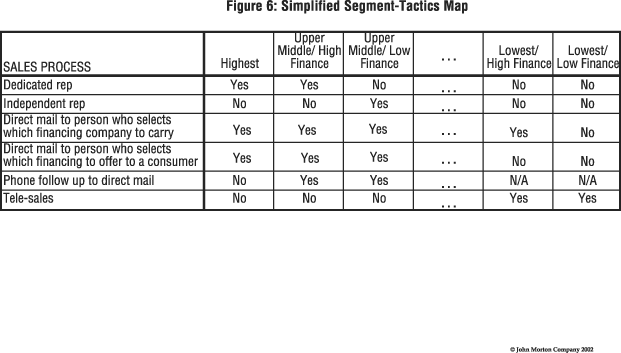 |
Figure 6 shows an example of a simplified segment-tactic map for one business process. In this case, the financing provider decided to address the top two segments via dedicated sales reps because of their high value to the business and their tenuous value proposition fit. To build value in these segments outside the current value proposition framework, it was necessary to dedicate someone to focus on the individual needs of each channel in the segment. This approach would build Inertia by continually identifying new needs that could be met and by developing strong personal relationships.
7. Map tactics back to functions
Finally, the segment tactics must be mapped back to the functional areas that will implement them. If the customer contact model documented at the start parallels the functional organization, the translation is straightforward. However, it is likely that the segment tactics will deviate from the current organization structure. In the course of analysis, new tactics may be identified as well as new functions. In this case, the syndicated research identified a super-segment that required an entirely new sales function.
In the example, the seven-step process produced a more direct impact on the business than would have been achieved otherwise. The research design, analysis, and strategy development were structured to meet the total business goal of $300 million. A new segment of super-size channels was identified that required a new corporate function. A new customer relationship model was identified to serve the highest opportunity segments, and resources were directed away from low opportunity segments. Finally, the process produced a set of segment-specific actions matched to internal functions that enabled the business to immediately begin to execute its market entry plan.
To summarize, B2B research delivers maximum value when a structured process is executed that continually integrates the research and the business planning function. In the seven-step process discussed here, six tools are used to guide the research design and analysis: 1) strategic framework, 2) market opportunity matrix, 3) segment scorecard, 4) segment-value proposition map, 5) segment-tactics map, and 6) tactics-function map. Following this seven-step process results in research efficiencies and greater value of the research to the business.
